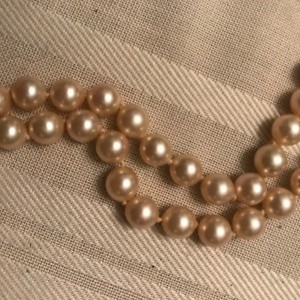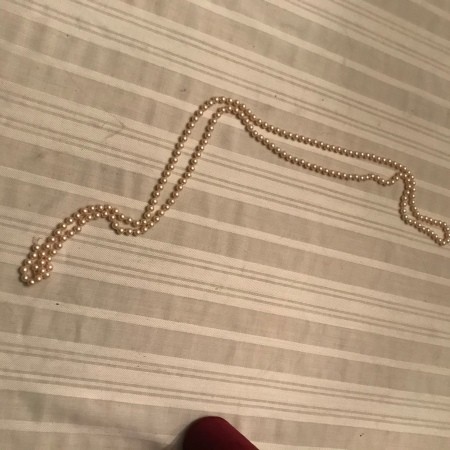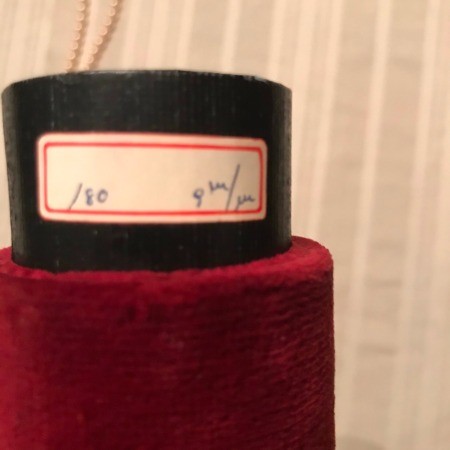 Are this Akoya pearls or Golden South Sea Pearls? I know it's difficult by means of a picture . There are 9 mm 180 pearls in total. Does anybody know its worth whether they are Akoya or Golden South Pearls? Any help is welcomed!
Are this Akoya pearls or Golden South Sea Pearls? I know it's difficult by means of a picture . There are 9 mm 180 pearls in total. Does anybody know its worth whether they are Akoya or Golden South Pearls? Any help is welcomed!


Add your voice! Click below to answer. ThriftyFun is powered by your wisdom!
Here is a link on the difference between the two pearl varieties www.angara.com/
That said, pearls are one thing I would never get any internet input on because they must be seen in person by an expert to be identified as genuine or not.
This is where I suggested you find at least 3 local jewelers you trust to help you with this process. Do not let them take the items out of your sight and ask that any verifications be done in person so they can show you what they see and why they say what they say.
They can help you value the pieces for your market also--as values may be slightly different in different locations.
Post back what you learn about yours. It can then be used as guidance to help others know what to look for...but again, identification must be done in person, by an expert or you risk getting false or misleading answers.
Blessings!
Your pearls look lovely but what are they?
I would say to take them to a high end jewelry store but I can tell that most jewelry stores have independently owned repair shops and some of these also include an appraiser. My personal experience with jewelry stores is they will usually not even look at an item if all you are wanting is information. Some may examine your item if you are wanting to sell but may not tell you what you have - only tell you what they will pay or maybe not on their wanted list.
That said, usually larger pawn shops will give free information and give you a price they would pay for your item. Can you trust them? Not really when you have something like this but here is where you can go to several and compare notes. Some of the shops will not know what they so do not provide any information and just take note of what they say. This can get tricky so good luck with your 'research'.
Selling your pearls online can be very tricky also as there are plenty of 'pearls' listed for sale claiming to be one or the other but generally no proof so anyone willing to pay big money will usually buy from a large jewelry store or a store that sells online.
All that I'm saying is that you should have an appraisal if these turn out to be authentic or it will be difficult to get their true value.
You do not say where these came from but that looks like a jewelers tag and box so were you provided any other information?
Provenance or paper stating more than size and number?
The string does not appear to have a clasp and pretty long to be a necklace even a double strand so do you have any information on why they are in this long strand?
Value can only be determined after you find out more information so please let us know how it goes.
You need to take the pearls to a jeweler and find out. No one here can tell just by looking at a picture
You need to take them to a reputable jeweler to have them evaluated.
As I understand it, you have already made sure that you have real pearls. The first and the easiest way to tell if a pearl is real is by feeling it: when you touch a real pearl, it feels cool and warms up when worn www.thepearlsource.com/
You also need to make sure you don't have freshwater pearls, since they can be the same color and the same round shape as your pearls.
Freshwater pearls have now emerged as rivals to Akoya pearls in both quality and value. Since the 1990s, a new class of round and lustrous freshwater pearls has emerged, in different sizes, shapes and colors. Freshwater pearls come from freshwater mussels and are primarily produced in China.
Freshwater pearls range in size from 2.0-3.0 mm to 14.0-15.0 mm and have different colors, most typically pastel shades of pink, peach, lavender and white. Dyed Freshwater pearls can be black, red, gold, green, purple, blue and pink. The most valuable Freshwater pearl shape is as close to a round as possible, but there are also symmetrical and free form Baroque.
Prices range from $ 30 to the high thousands.
Freshwater pearl is nearly 100% solid crystalline nacre and therefore is very durable. www.alibaba.com/
Akoya pearl is a saltwater cultured pearl from the akoya oyster (Pinctada fucata martensii). Akoya pearls are farmed in Japan, China and to a lesser extent, Vietnam, Thailand and Australia. These pearls have the highest mirror-like luster and the greatest shine of all cultured pearls. They have inherently perfect round shapesare and called Eight Way Rollers in the Pearl Industry as these pearls will roll evenly in every direction when placed on a flat surface.
Akoya pearls range in size from 2.0-3.0 mm up through 9.0-9.5 mm, and very rarely, 9.5-10.0 mm. Traditional Akoya pearl colors are usually white, but also include natural Silvery-Blue and even Golden hues. The most valuable and traditional shape is a true, perfect round, but free form Baroque shapes are also available.
Prices range from $ 75 to the high thousands. www.premiumpearl.com/
South Sea pearls are known for their incredible size and beautiful satin luster. They are saltwater pearls that are cultivated from the oyster (Pinctada), found centering on Northern Australia and South-East Asia, including Myanmar and Indonesia.
South Sea pearls range in size from 8.0-9.0 mm up through 20.0 mm. The South Sea pearl oyster varieties produce natural shades of White and Gold pearls. South Sea pearls that are perfectly round are the most valuable and rare. Free form baroque, circled baroque and smooth baroque shapes that are symmetrical comprise the vast majority of shapes in each yearly pearl harvest.
Prices range from $ 200 to the tens of thousands.
Cultured South Sea pearls have the thickest nacre layers of all saltwater cultured pearl types. This why the South Sea pearl has the trademark satiny luster that imparts a subtle glow rather than the hard shine of the Akoya pearl. thesouthseapearl.com/
As you can see, the size, color and shape of your pearls are suitable for all these types of pearls. Therefore, carefully examine your pearls to see if they have a perfectly round shape, which is typical for Akoya pearls. Freshwater pearls have a much larger variety of shapes. Then pay close attention to the shine. It is very difficult to do this using your photos. If the shine is like a mirror, then you have Akoya pearls, if the shine is low, then you have Freshwater pearls, if the shine is satiny, then you have South Sea pearls.
The value of pearls is determined using various factors:
pearl type/origin - Freshwater pearls is least expensive, saltwater Akoya - mid-range, South Sea - highest,
shape - the rounder the pearl, the more value it holds,
size - larger pearls are more valuable than smaller ones,
color,
surface - pearls with smooth surface are more highly valued than those with multiple inclusions,
nacre quality,
luster - the sharper the luster, the more valuable the pearl.
To find a more accurate price, show your pearls to a jeweler.
Add your voice! Click below to answer. ThriftyFun is powered by your wisdom!